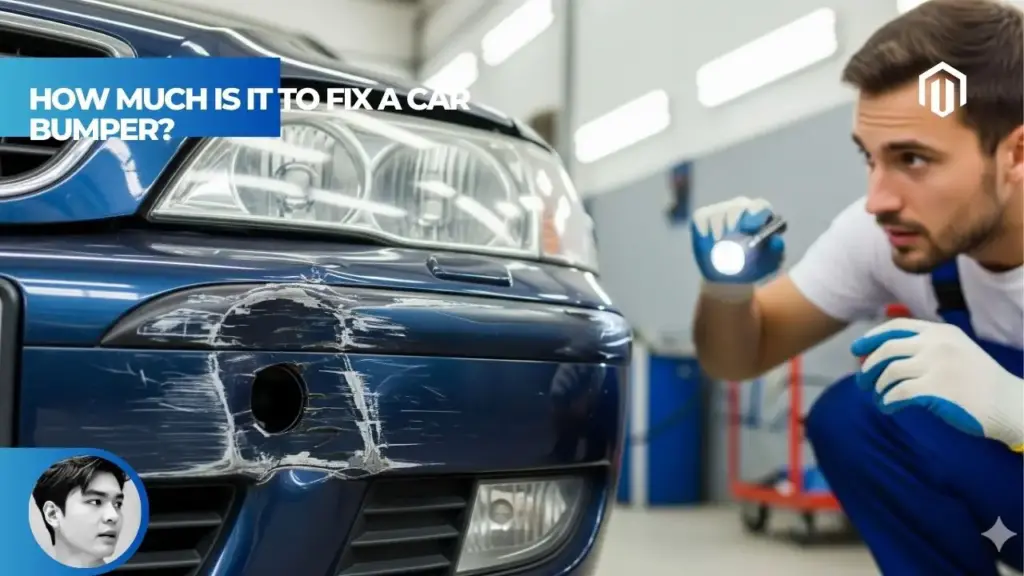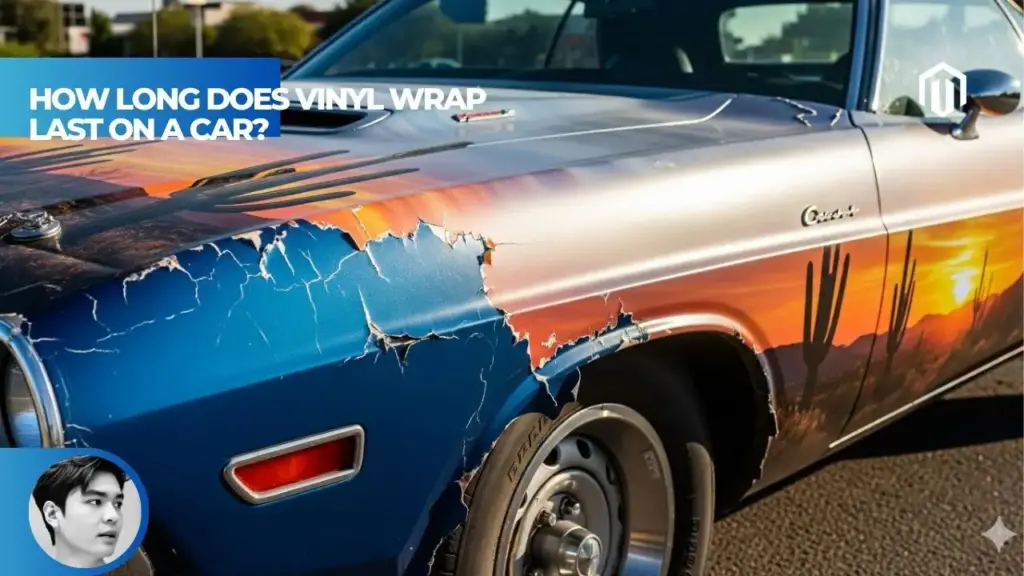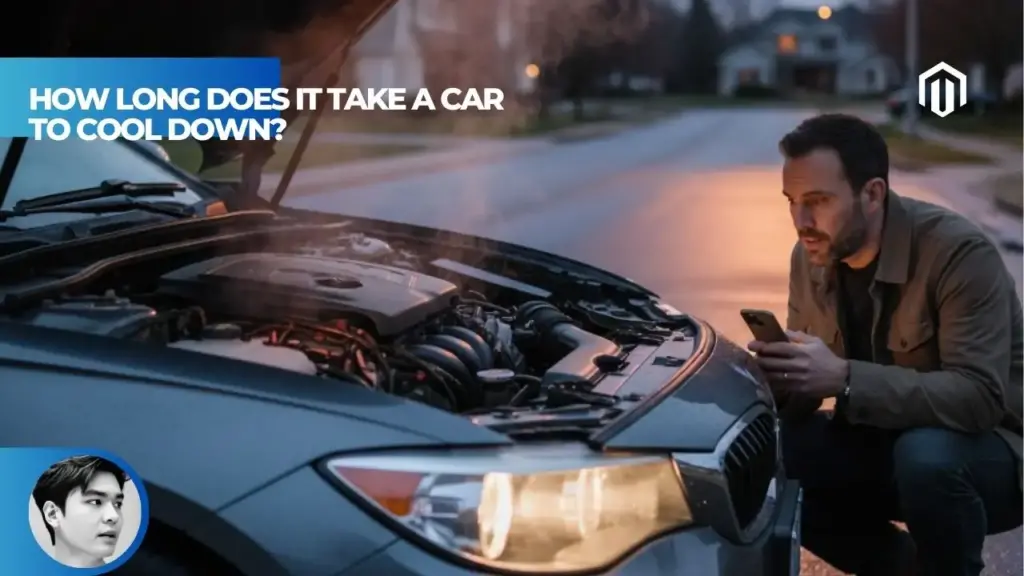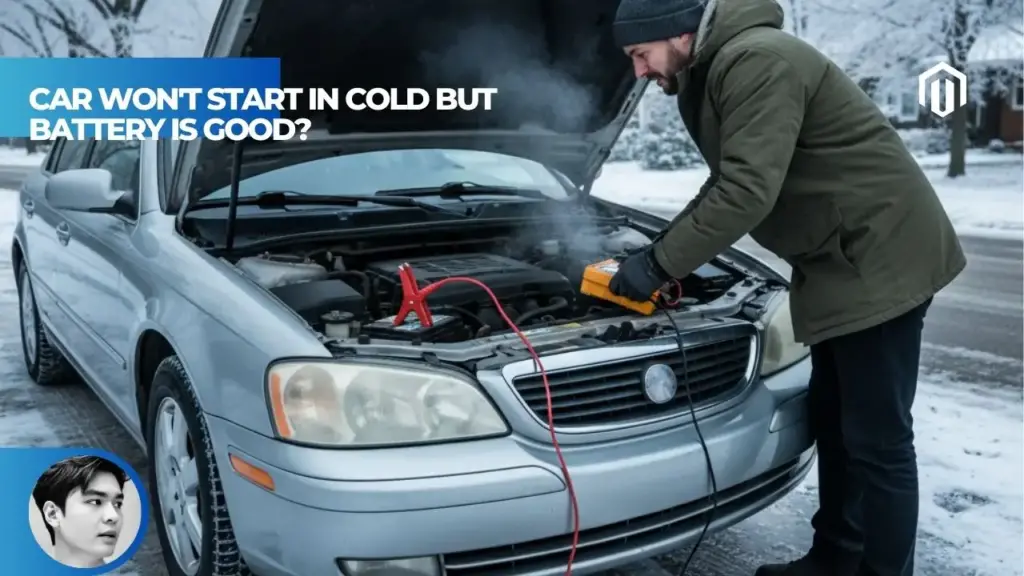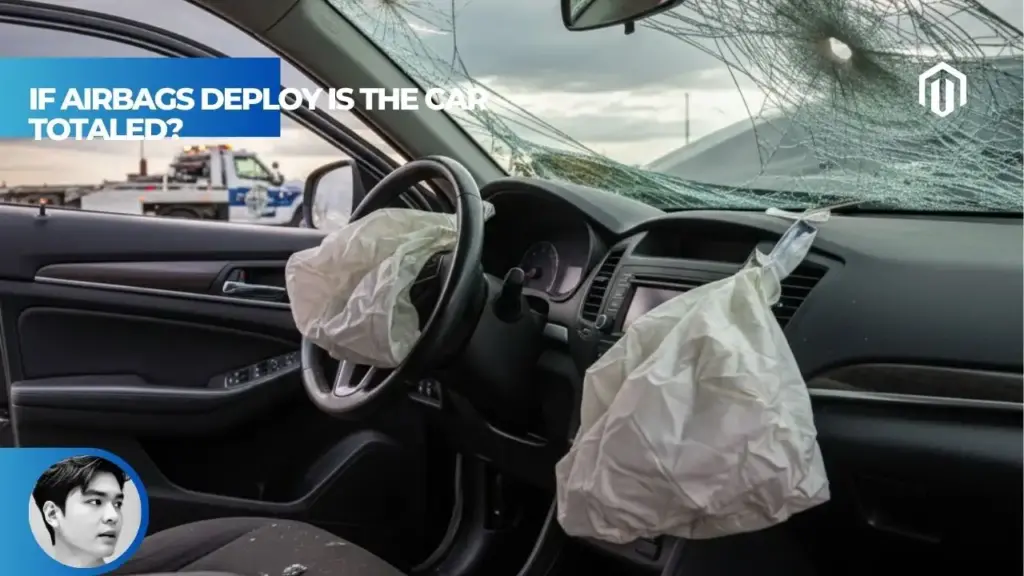You may also like:
- 【Explained】If Airbags Deploy, Is the Car Totaled? (The 2025 Cost vs. Value Guide)
- 【Explained】Is It Cheaper to Wrap or Paint a Car? Complete Cost Breakdown
- 【Explained】How Much Does It Cost to Epoxy 2 Car Garage?
- 【Explained】What’s the Maintenance Cost for BMW? 10-Year Ownership Averages and Budgeting
- 【Explained】How Much Does It Cost to Tint Car Windows? (By Tint Type)
Car bumper repair costs range from $150 for minor scratches to over $2,000 for full replacement on luxury vehicles with advanced sensors. The exact price depends on damage severity, vehicle type, and whether you choose repair or replacement—with most common repairs like dents and scuffs falling between $300-$600 at professional body shops.
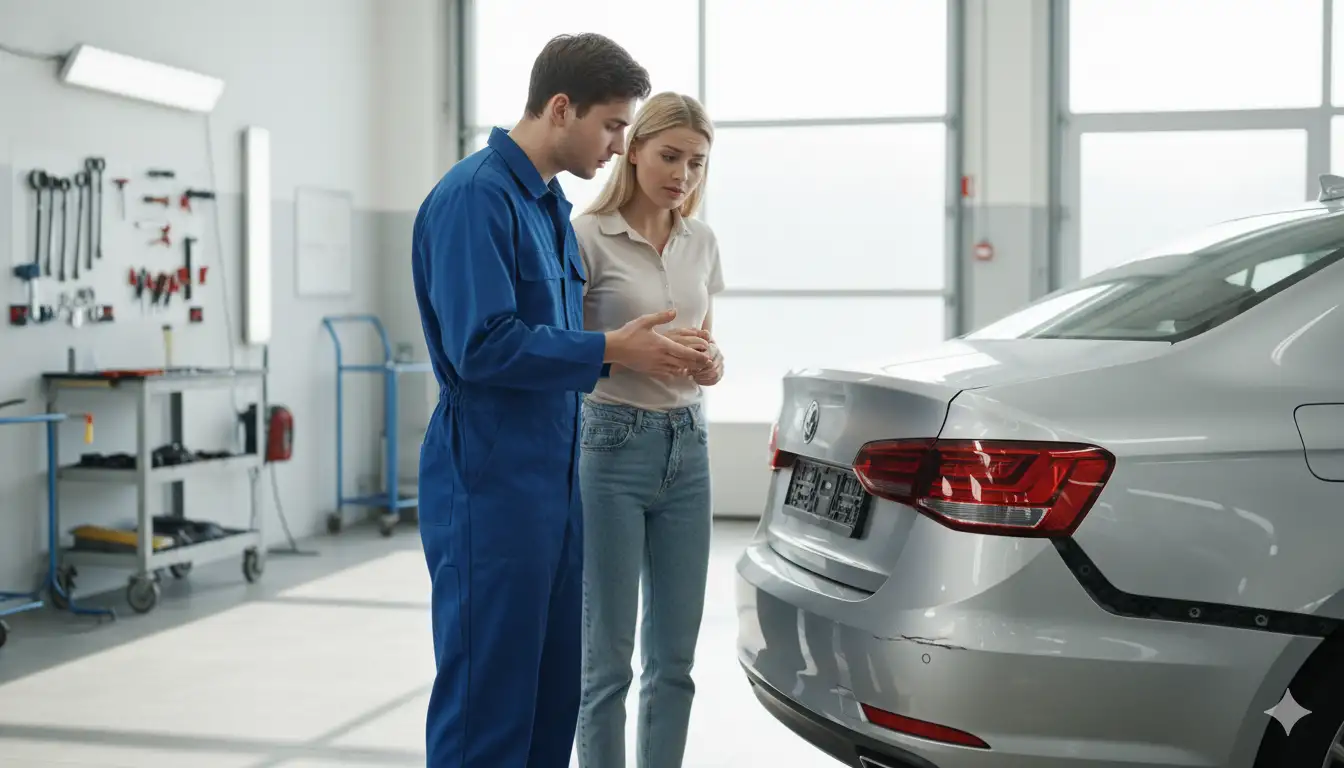
Average Cost to Fix a Car Bumper
Understanding bumper repair costs starts with recognizing the wide price spectrum based on damage type and repair method. Modern vehicles feature complex bumper systems that integrate safety sensors, cameras, and structural components, making accurate cost estimation essential for budgeting decisions.
Bumper Repair vs Replacement Cost Overview
The decision between repair and replacement fundamentally impacts your total expense. Repairs typically cost $150-$600 for minor to moderate damage, while replacement ranges from $500-$2,500 including parts and labor[1]. According to industry data, repairs become cost-effective when damage affects less than 50% of the bumper surface area and doesn’t compromise structural integrity.
Professional body shops evaluate three key factors: damage extent, repair time required, and paint matching complexity. A repair that takes 2-3 hours of skilled labor costs significantly less than a full replacement requiring bumper removal, new part installation, and sensor recalibration. Autvex experts recommend getting repair quotes first, as modern plastic welding techniques can fix damage previously requiring replacement.
Price for Minor Bumper Scratch Repair ($150-$600)
Minor scratches represent the most common and affordable bumper repairs. Surface-level scratches cost $150-$300 to fix, while deeper scratches reaching the plastic substrate range from $300-$600[2]. The price variation depends on scratch length, location, and whether paint blending into adjacent panels is necessary.
Body shops typically address minor scratches through a three-step process: sanding, primer application, and paint matching. For scratches under 6 inches, many shops offer spot repairs that avoid repainting the entire bumper, saving $200-$400. Mobile repair services specializing in minor damage often charge 30-40% less than traditional shops for comparable scratch repairs.
Cost to Fix a Cracked Plastic Bumper ($400-$900+)
Cracked bumpers require specialized repair techniques that significantly impact pricing. Plastic welding repairs cost $300-$500 for single cracks, while multiple cracks or spider web damage can push costs to $600-$900[1]. The repair involves heating and fusing the plastic, reinforcing with mesh backing, and complete refinishing.
Modern thermoplastic bumpers respond well to professional welding when cracks are under 12 inches. However, cracks near mounting points or sensor locations often necessitate replacement for safety reasons. Insurance adjusters typically recommend replacement when crack repair costs exceed 60% of a new bumper price, making the $500-$600 range a critical decision point.
Car Bumper Replacement Cost by Car Model
Vehicle make and model dramatically affect replacement costs. Economy cars like Honda Civic or Toyota Corolla average $500-$800 for complete bumper replacement, while luxury vehicles can exceed $2,000-$3,000[3]. Here’s a breakdown by vehicle category:
| Vehicle Category | Average Replacement Cost | Example Models |
|---|---|---|
| Economy | $500-$800 | Civic, Corolla, Sentra |
| Mid-Size | $700-$1,200 | Accord, Camry, Altima |
| SUV/Truck | $900-$1,500 | F-150, Tahoe, Explorer |
| Luxury | $1,500-$3,000 | BMW 5 Series, Audi Q7, Mercedes E-Class |
| Performance | $2,000-$4,000 | Corvette, Porsche 911, BMW M3 |
Cost Breakdown by Damage Type and Severity
Different damage types require specific repair approaches, each with distinct cost implications. Understanding these categories helps you communicate effectively with repair shops and insurance adjusters.
Cost to Fix Dented Bumper
Bumper dents vary widely in repair complexity and cost. Small dents (under 2 inches) cost $150-$250 using paintless dent repair (PDR), while larger dents requiring traditional bodywork range from $300-$1,200[1]. The dent’s location matters significantly—corner dents cost more due to access difficulty.
PDR works exceptionally well for shallow dents without paint damage, offering same-day service at reduced cost. Traditional dent repair involving body filler and repainting takes 1-2 days but handles severe deformations. For context, fixing a shopping cart dent typically costs $200-$350, while collision damage from backing into a pole averages $500-$800.
Minor Bumper Scratch Repair Price
Beyond basic scratches, minor scuffs and paint transfer from parking incidents represent a distinct pricing category. Paint transfer removal costs $50-$150 when no actual scratch exists, while scuff marks requiring touch-up paint range from $150-$400[2]. Many drivers don’t realize that apparent damage often cleans off with proper techniques.
Professional detailers can sometimes eliminate minor marks for under $100 using compound polishing. However, once the clear coat is penetrated, professional painting becomes necessary. The difference between a $150 buff-out and a $400 respray often comes down to scratch depth, making professional assessment valuable before committing to repairs.
Cost to Fix Popped Out Bumper
Bumpers that pop out from their clips present a unique repair scenario. Simple reattachment costs $50-$150 when clips remain intact, but broken mounting points require $200-$500 in repairs[1]. This damage commonly occurs from parking mishaps or snow bank encounters.
The repair complexity depends on clip condition and bumper alignment. Technicians often discover hidden damage during reattachment, particularly bent reinforcement bars or broken mounting tabs. What appears as a simple pop-out might require bracket replacement, explaining why estimates can increase from initial visual inspection.
Cost for Bumper Scuff Repair
Scuff marks from parallel parking or garage walls create distinctive damage patterns. Light scuffs cost $150-$300 to repair, while deep scuffs with plastic deformation range from $400-$600[2]. The repair process involves sanding, filling, priming, and color-matching to blend seamlessly.
Scuff location impacts repair difficulty—lower bumper scuffs near the ground require complete bumper painting more often than mid-level damage. Multiple scuffs across the bumper face might make complete replacement more economical than individual repairs, particularly when labor costs accumulate.
Light Damage vs Severe Damage Cost
Understanding damage severity helps predict repair costs accurately. Light damage (scratches, small dents, scuffs) typically costs $150-$600, while severe damage (large cracks, multiple impact points, structural compromise) ranges from $800-$2,000+[3]. The transition point often occurs around $800, where replacement becomes more practical.
Insurance companies use specific criteria to classify damage severity. Light damage maintains bumper structural integrity and affects less than 25% of surface area. Severe damage compromises mounting points, affects multiple panels, or requires extensive reconstruction. This classification directly impacts whether insurers authorize repair or replacement.
Bumper Damage Requiring Replacement
Certain damage patterns mandate complete replacement regardless of cost considerations. Structural damage to mounting points, tears exceeding 6 inches, or damage affecting integrated sensors typically require new bumpers[1]. Replacement becomes necessary when repair costs exceed 70% of new bumper price or when safety compliance is questionable.
Common replacement triggers include high-speed impacts, multiple previous repairs, and damage to bumper reinforcement bars. Modern bumpers with integrated radar sensors for adaptive cruise control often require replacement even for moderate damage, as sensor alignment proves impossible after significant deformation.
Vehicle-Specific Factors Affecting Repair Costs
Your vehicle’s make, model, and features significantly influence repair pricing. Understanding these factors helps explain cost variations between similar damage on different vehicles.
Bumper Repair Cost Luxury Car
Luxury vehicles command premium repair prices due to specialized materials and integrated technology. BMW, Audi, and Mercedes bumper repairs cost 30-50% more than mainstream brands, with minor repairs starting at $500 and replacements exceeding $3,000[3]. The 2025 BMW 2 Series, for example, features complex sensor arrays that add $500-$800 to replacement costs.
Paint matching on luxury vehicles requires special techniques for metallic and pearl finishes. Factory-specific paint codes and multi-stage application processes add $200-$500 to standard painting costs. Additionally, luxury brands often require OEM parts for lease returns or warranty compliance, eliminating cheaper aftermarket options.
Front Bumper Replacement Cost
Front bumpers typically cost 20-30% more than rear bumpers due to additional components and complexity. Average front bumper replacement ranges from $900-$2,500 including parts, paint, and labor[1]. Front bumpers house fog lights, air intake ducts, and increasingly common radar sensors for safety systems.
The integration of advanced driver assistance systems (ADAS) significantly impacts front bumper costs. Vehicles with adaptive cruise control, automatic emergency braking, and parking sensors require $300-$750 in additional calibration after bumper replacement[4]. This calibration ensures safety systems function properly, making it non-negotiable for modern vehicles.
Rear Bumper Repair Cost
Rear bumper repairs generally cost less than front repairs, averaging $500-$1,500 for replacement[2]. However, vehicles with backup sensors, cameras, and trailer hitch receivers can approach front bumper pricing. Rear damage often involves exhaust system interference, adding complexity to repairs.
Common rear bumper damage from backing incidents typically costs $300-$700 to repair. The presence of parking sensors adds $150-$300 to repair costs when sensor replacement or recalibration is needed. Vehicles with hands-free liftgates featuring kick sensors beneath rear bumpers face additional expenses for sensor replacement and programming.
SUV Bumper Repair Cost
SUVs and trucks present unique repair challenges due to size and construction. SUV bumper repairs range from $400-$800 for minor damage to $1,200-$2,500 for replacement[3]. Larger bumpers require more materials and paint, while higher mounting positions can complicate repair access.
The popularity of off-road capable SUVs introduces additional cost factors. Steel bumpers on trucks cost significantly more than plastic bumpers, with replacement prices reaching $2,000-$3,500. Chrome bumpers common on trucks add $300-$600 to refinishing costs compared to painted alternatives.
Bumper Cost with Sensors and Cameras
Modern safety technology dramatically impacts repair costs. Bumpers with integrated sensors add $500-$1,500 to base repair prices, while 360-degree camera systems can add $1,000-$2,000[4]. A simple parking sensor costs $75-$150 each, with most bumpers housing 4-8 sensors.
Recalibration represents a hidden cost many drivers overlook. After bumper replacement on sensor-equipped vehicles, ADAS calibration costs $150-$750 depending on system complexity[4]. This process requires specialized equipment and trained technicians, explaining why dealer repairs often cost more than independent shops.
OEM vs Aftermarket Bumper Price
Part selection significantly impacts total repair cost. OEM bumpers cost 50-100% more than aftermarket alternatives, with OEM parts ranging from $400-$1,500 versus $200-$800 for aftermarket[2]. However, this comparison requires careful consideration of quality, fit, and warranty implications.
| Part Type | Average Cost | Pros | Cons |
|---|---|---|---|
| OEM | $400-$1,500 | Perfect fit, warranty approved | Higher cost, limited availability |
| Aftermarket | $200-$800 | Lower cost, readily available | Variable quality, fit issues possible |
| Certified Aftermarket | $300-$1,000 | Good quality, moderate cost | Limited selection |
| Used OEM | $200-$600 | OEM quality, lower cost | May have hidden damage |
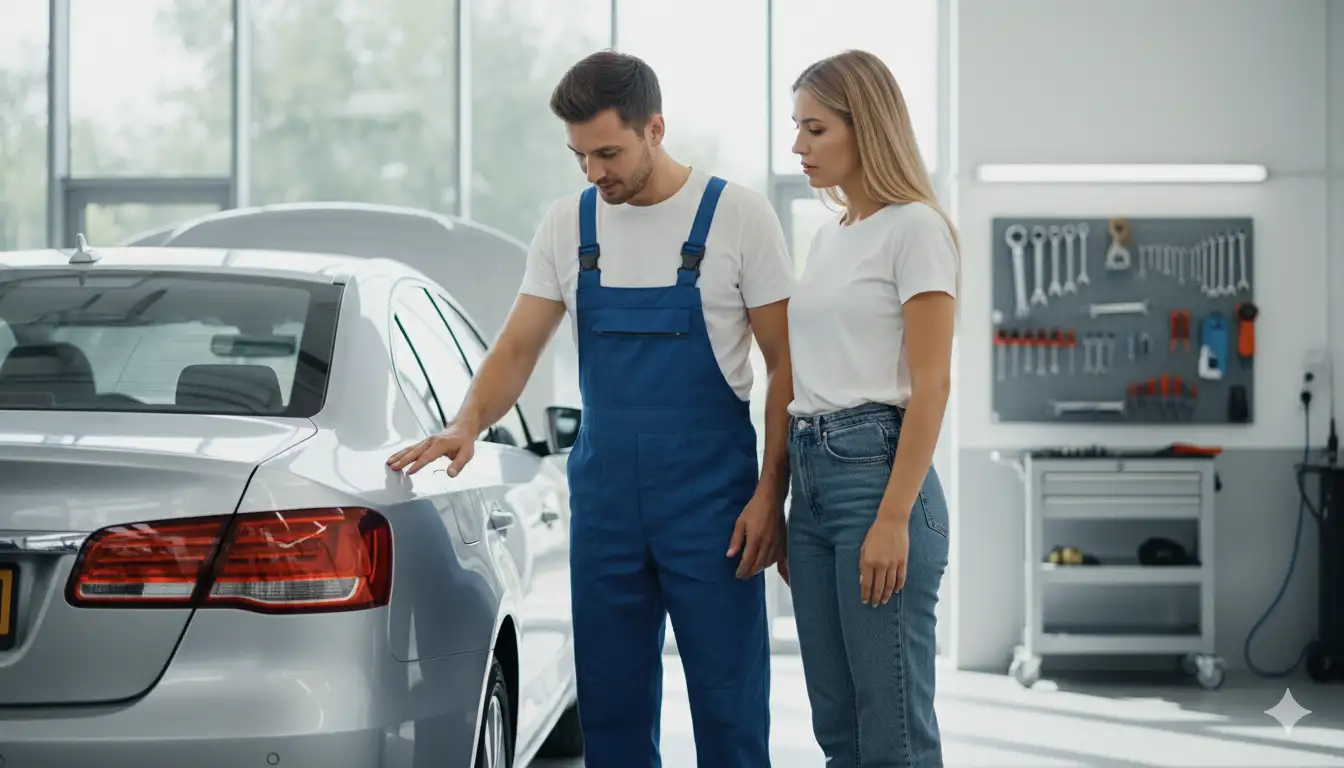
Labor and Paint Costs
Labor and paint represent substantial portions of bumper repair expenses. Understanding these components helps evaluate quotes and identify potential savings.
How Much Does Body Shop Charge for Bumper Repair
Body shop labor rates vary significantly by location and shop type. Independent shops charge $47-$100 per hour, while dealership body shops charge $100-$215 per hour[2]. Most bumper repairs require 2-4 hours of labor, making shop selection impact total cost by $200-$400.
Geographic location heavily influences labor rates. California and Northeast shops charge 40-60% more than Midwest or Southern locations. Urban areas command premium prices, with Manhattan shops charging double rural rates. Autvex recommends comparing at least three quotes, as labor rate variations can exceed material cost differences.
Labor Cost to Replace Bumper Cover
Bumper replacement labor typically requires 2-4 hours at $200-$600 total cost[1]. This includes removal of the damaged bumper, preparation of mounting points, installation of the new bumper, and initial alignment. Complex vehicles with extensive sensor integration require additional labor time.
The labor breakdown includes:
- Bumper removal: 30-45 minutes
- Mounting point preparation: 30-60 minutes
- New bumper installation: 45-60 minutes
- Sensor transfer/connection: 30-90 minutes
- Final adjustment: 15-30 minutes
Cost to Paint a Bumper Cover
Professional bumper painting costs $200-$500 depending on paint type and color complexity[3]. Single-stage colors cost less than metallic or pearl finishes requiring multiple coats. The painting process includes surface preparation, primer application, base coat, clear coat, and curing time.
Paint material alone costs $50-$150, with premium automotive paint reaching $75 per pint. Labor for proper painting requires 3-5 hours including prep work, making it the most time-intensive aspect of bumper repair. Environmental regulations in some states add disposal fees for paint materials, increasing costs by $25-$50.
How Much Does Paint Matching Add to the Bumper Repair Cost
Color matching and blending adds $200-$500 to base painting costs[2]. This process ensures the repaired bumper matches adjacent panels perfectly, requiring skilled technicians and specialized equipment. Tri-coat pearls and complex metallics cost 20-30% more than solid colors.
Factors affecting paint matching costs include:
- Vehicle age (faded paint requires more blending)
- Paint type (metallic/pearl vs. solid)
- Number of adjacent panels requiring blending
- Color difficulty (white/silver show imperfections more)
- Previous paint work quality
Alternative Repair Options and DIY Solutions
Cost-conscious drivers have several alternatives to traditional body shop repairs. These options trade convenience or perfection for significant savings.
DIY Bumper Repair Cost
DIY repairs can reduce costs by 60-80%, with materials costing $50-$200 for most minor repairs[5]. Basic supplies include sandpaper, body filler, primer, paint, and clear coat. However, DIY success depends heavily on damage type and individual skill level.
Common DIY repair costs:
- Scratch repair kit: $20-$50
- Plastic welding kit: $40-$80
- Complete paint supplies: $75-$150
- Bumper clips/fasteners: $15-$30
The main drawback involves time investment and result quality. What takes professionals 2-3 hours might require 8-10 hours for beginners. Additionally, safety system warnings may appear if sensors aren’t properly reinstalled.
Paintless Dent Repair (PDR) Bumper Cost
PDR offers an affordable solution for specific damage types, costing $150-$250 versus $300-$600 for traditional repairs[1]. This technique works best on plastic bumpers with shallow dents where paint remains intact. The process involves accessing the bumper’s back side and massaging out dents without repainting.
PDR limitations include inability to fix paint damage, cracks, or sharp creases. Success rates vary by bumper material—thermoplastic bumpers respond better than thermoset plastics. Mobile PDR services often charge less than shops while providing convenient on-site repairs.
Plastic Welding for Bumpers Cost
Professional plastic welding costs $300-$500, offering a middle ground between basic repairs and replacement[1]. This technique permanently fuses cracked plastic using heat and reinforcing materials. The repair strength often exceeds original bumper integrity when performed correctly.
The process involves:
- Crack preparation and alignment ($50-$75 labor)
- Welding with reinforcement mesh ($100-$150 labor)
- Surface finishing and contouring ($75-$100 labor)
- Painting and blending ($150-$200)
Mobile Bumper Repair Service Cost
Mobile repair services charge $150-$500 for on-site bumper repairs, typically 20-40% less than body shops[2]. These services handle minor to moderate damage at your location, eliminating transportation hassles. Most mobile technicians specialize in small dents, scratches, and scuffs repairable within 2-3 hours.
Mobile service advantages include convenience and competitive pricing for minor repairs. However, they can’t handle major structural damage or complex paint matching requiring spray booth environments. Weather conditions also affect service availability and repair quality.
Insurance Coverage and Decision Making
Insurance considerations often determine repair approaches. Understanding coverage implications helps optimize claim decisions and minimize out-of-pocket expenses.
Should I Claim Bumper Damage on Insurance
Filing claims for bumper damage requires careful cost-benefit analysis. Claims make sense when repair costs exceed your deductible by at least $500-$1,000[6]. However, premium increases following claims can offset savings, particularly for at-fault accidents.
Consider these factors:
- Deductible amount versus repair cost
- Fault determination
- Claims history and premium impact
- Future insurability concerns
- Diminished value considerations
Insurance experts recommend paying out-of-pocket for repairs under $1,000 to avoid premium increases averaging 20-40% for at-fault claims[6].
Insurance Deductible for Bumper Repair
Standard deductibles range from $250-$1,000, with $500 being most common[6]. Your deductible represents the amount paid before insurance coverage begins. For example, with a $500 deductible and $1,500 repair bill, insurance pays $1,000 while you pay $500.
Comprehensive coverage (for non-collision damage) often carries different deductibles than collision coverage. Understanding which coverage applies helps predict out-of-pocket costs. Vandalism, weather damage, and animal strikes fall under comprehensive, while accident damage uses collision coverage.
Is a $500 Repair Cost Worth Claiming on Insurance
Generally, repairs under $1,000 shouldn’t trigger insurance claims unless you have a $250 or lower deductible[6]. Premium increases from claims often exceed initial savings within 2-3 years. Additionally, claims history affects future insurance shopping, potentially limiting carrier options.
For perspective, a single at-fault claim increases premiums by an average of $400-$800 annually. Over three years, this $1,200-$2,400 increase far exceeds the savings from claiming a $500 repair. Many insurers offer accident forgiveness for first claims under $500, but this protection typically applies once per policy period.
Does Insurance Cover Bumper Repair
Collision coverage pays for accident damage, while comprehensive covers non-collision events[6]. Liability coverage doesn’t protect your vehicle, only damage you cause to others. Full coverage combining collision and comprehensive handles most bumper damage scenarios minus deductibles.
Coverage specifics that matter:
- At-fault accidents: Collision coverage applies
- Hit-and-run: Collision or uninsured motorist coverage
- Parking damage: Collision coverage
- Weather/vandalism: Comprehensive coverage
- Other driver at-fault: Their liability coverage
Timeline and Process Information
Understanding repair timelines helps plan transportation and set realistic expectations. Repair duration affects rental car costs and daily inconvenience.
Time to Fix a Car Bumper
Repair timeframes vary dramatically by damage severity. Minor repairs take 2-4 hours, while full replacements require 1-3 days[1]. Paint drying and curing represent the primary time constraints, as modern paints require specific temperature and humidity conditions.
Typical repair timelines:
- Scratch repair: 2-4 hours
- Dent repair (PDR): 1-2 hours
- Minor crack welding: 4-6 hours
- Bumper replacement: 1-2 days
- Complex replacement with sensors: 2-3 days
How Long Does It Take to Fix a Car Bumper
The complete repair process involves multiple stages affecting total duration. Assessment takes 30-60 minutes, followed by parts ordering (0-5 days for availability), actual repair (2-8 hours), and paint curing (12-24 hours)[2]. Express services offering same-day repairs charge 20-30% premiums.
Factors extending repair time include:
- Parts availability (especially OEM)
- Paint matching complexity
- Discovery of hidden damage
- Shop workload and scheduling
- Weather conditions affecting painting
Scheduling repairs during slower periods (January-February, July-August) often reduces wait times and may offer discount opportunities.
What Is Included in the Labor Cost for Bumper Replacement
Labor charges encompass multiple services beyond simple installation. The $200-$600 labor cost includes bumper removal, surface preparation, installation, alignment, and basic quality control[1]. Additional services like sensor calibration, electrical connections, and paint work carry separate charges.
Detailed labor breakdown:
- Diagnostic inspection: $50-$100
- Old bumper removal: $75-$125
- Surface/mounting preparation: $50-$100
- New bumper installation: $100-$150
- Sensor transfer/calibration: $150-$750
- Final adjustment/test: $25-$50
Understanding these components helps identify potential overcharges and negotiate fair pricing.
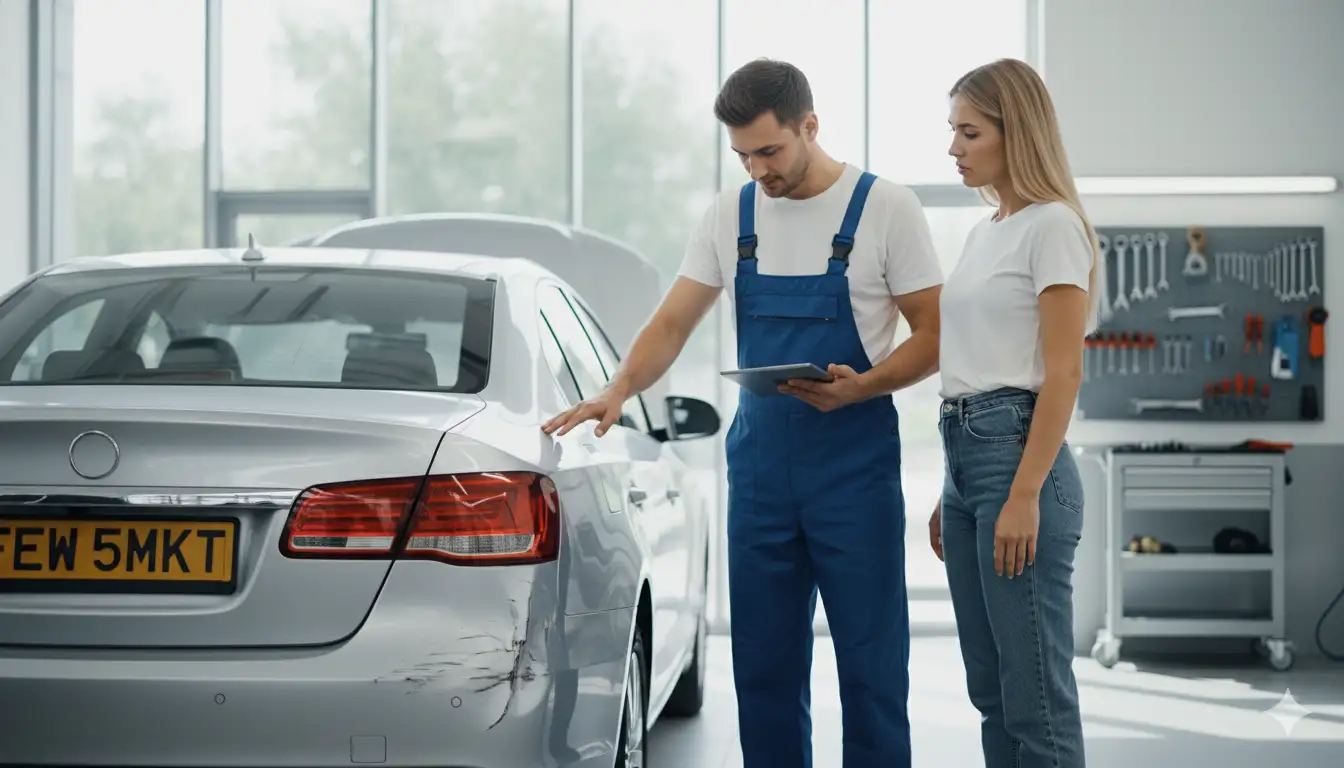
Key Takeaways
- Minor bumper repairs cost $150-$600 while replacement ranges from $500-$2,000+ depending on vehicle type
- PDR offers 40-60% savings for dents without paint damage, costing $150-$250 versus traditional repairs
- Luxury vehicles and those with sensors cost 30-50% more due to technology and paint complexity
- Insurance claims under $1,000 rarely make financial sense due to deductibles and premium increases
- Mobile repair services save 20-40% on minor damage while providing convenient on-site service
- DIY repairs can save 60-80% but require significant time investment and may compromise quality
- Front bumpers cost 20-30% more than rear bumpers due to additional components and sensors
Decision Path / Next Steps
After assessing your bumper damage, follow this strategic approach to minimize costs while ensuring quality repairs. First, photograph the damage extensively from multiple angles and distances—these images prove valuable for insurance claims and repair quotes. Clean the damaged area thoroughly, as apparent damage often looks worse than reality due to dirt and paint transfer.
Obtain 3-4 repair estimates from different shop types: dealership body shop, independent certified shop, and mobile repair service. Request detailed breakdowns separating parts, labor, and paint costs. Ask specifically about used OEM parts options which can save 40-60% while maintaining quality. For vehicles under warranty or lease, verify whether aftermarket parts affect coverage.
Evaluate the insurance decision carefully. Calculate total claim value minus deductible, then multiply your current premium by 0.3 to estimate annual increase potential. If the difference is under $500, pay out-of-pocket. For newer vehicles with comprehensive sensor systems, confirm whether your policy covers ADAS recalibration costs separately from body work.
Consider timing strategically—body shops offer discounts during slow seasons (January-February, mid-summer). If damage is cosmetic only, delaying repairs until these periods can save 10-20%. However, exposed metal or compromised sensors require immediate attention to prevent rust or safety issues.
For repairs under $500, explore mobile repair services or paintless dent repair specialists who offer convenience and value. These services work particularly well for parking lot damage and minor incidents. Ensure any service provider offers warranty coverage—reputable shops guarantee work for at least one year.
Finally, if choosing DIY repairs, invest in quality materials and allocate sufficient time. Watch manufacturer-specific repair videos and practice techniques on hidden bumper areas first. Remember that improper repairs can decrease vehicle value more than living with minor damage, particularly for future resale considerations.
Autvex recommends documenting all repairs with receipts and photos for resale value protection. Whether choosing professional repair or DIY approaches, maintaining detailed records proves essential for warranty claims, insurance documentation, and demonstrating proper vehicle maintenance to future buyers.
Frequently Asked Questions
Is it cheaper to repair a bumper or replace it?
Repair is typically cheaper for minor damage ($150-$600) while replacement ($500-$1,500+) becomes cost-effective when repair costs exceed 60% of replacement price or structural damage exists[1]. The break-even point usually occurs around $700-$900 in repair costs.
How much does a body shop charge to fix a bumper dent?
Body shops charge $300-$1,200 for dent repairs depending on size and paint damage[1]. Small dents with intact paint cost $150-$250 using PDR, while large dents requiring traditional bodywork and repainting range from $500-$1,200.
Does insurance cover bumper repair?
Yes, collision coverage covers at-fault accidents while comprehensive covers vandalism and weather damage[6]. Consider your deductible versus repair cost before filing, as claims under $1,000 often aren’t worth potential premium increases.
How long does it take to fix a car bumper?
Minor repairs take 2-4 hours while full replacement requires 1-3 days including paint drying time[2]. Sensor recalibration and complex paint matching can extend timelines to 3-4 days for luxury vehicles.
Can a cracked plastic bumper be repaired?
Yes, plastic welding can repair cracks for $300-$500, but large cracks or multiple damage points typically require replacement for safety[1]. Cracks under 12 inches respond well to professional welding techniques.
What is the average cost to replace a front bumper?
Front bumper replacement averages $900-$2,500 including parts, paint, and labor[3]. Costs increase significantly with integrated sensors, cameras, and adaptive cruise control systems requiring calibration.
How much does it cost to fix a scuff mark on a bumper?
Simple scuff repairs cost $150-$600 depending on depth and paint damage[2]. Surface scuffs can often be buffed out for under $200, while deep scuffs requiring repainting cost $400-$600.
Is a $500 repair cost worth claiming on insurance?
Generally no if your deductible is $500+ or you risk premium increases[6]. Pay out-of-pocket for repairs under $1,000 to avoid rate hikes averaging 20-40% for at-fault claims.
What is included in the labor cost for bumper replacement?
Labor includes removal, installation, alignment, paint prep/application, and sensor recalibration, typically charging $200-$600 for 2-4 hours work[1]. Complex vehicles with ADAS features require additional calibration time.
How much does paint matching add to the bumper repair cost?
Paint matching adds $200-$500 for color blending into adjacent panels[3]. Metallic and pearl finishes cost 20-30% more than solid colors due to complex application requirements.
Can I replace a bumper myself to save money?
DIY replacement saves $200-$600 in labor but requires tools, skills, and 4-8 hours[5]. Paint and sensor calibration still need professional service, limiting actual savings to $200-$400 for most drivers.
How much does a new bumper cover cost without installation?
Bumper covers cost $200-$800 for aftermarket or $400-$1,500 for OEM parts[2]. Luxury and specialty vehicles can exceed $2,000 for parts alone, especially with integrated technology.
Do I need a full bumper replacement for a deep scratch?
Not usually—deep scratches can be filled, sanded, and repainted for $300-$600[1]. Replace only if scratches expose structural damage or compromise mounting points.
What are the costs for bumper repairs on luxury vehicles?
Luxury vehicle bumper repairs cost 30-50% more than standard cars, ranging $500-$1,000 for minor repairs to $3,000+ for replacement with technology features[3]. Paint matching and OEM parts requirements drive higher costs.
References
- Harry’s Collision. (2024). Cost Breakdown: Bumper Repair vs. Bumper Replacement. harryscollision.com. Retrieved from https://autvex.com/how-much-is-it-to-fix-a-car-bumper
- Westside Collision. (2025). Bumper Repair Cost: What to Expect in 2025. westsidecollision.com. Retrieved from https://autvex.com/how-much-is-it-to-fix-a-car-bumper
- Carlos Repairs Ridge. (2025). Auto Body Shop Services and Costs: What You Need to Know. carlosrepairsridge.com. Retrieved from https://autvex.com/how-much-is-it-to-fix-a-car-bumper
- AAA. (2025). ADAS Sensor Calibration Increases Repair Costs. aaa.com. Retrieved from https://autvex.com/how-much-is-it-to-fix-a-car-bumper
- Mobile Brewer. (2025). What to Expect from Auto Body Repair Costs in 2025. mobilebrewer.com. Retrieved from https://autvex.com/how-much-is-it-to-fix-a-car-bumper
- Progressive. (2025). Does Car Insurance Cover Bumper Damage? progressive.com. Retrieved from https://autvex.com/how-much-is-it-to-fix-a-car-bumper

I am a senior automotive analyst at Autvex. Expert vehicle evaluations, in-depth reviews, and objective analysis helping readers make informed automotive decisions with years of industry experience.

